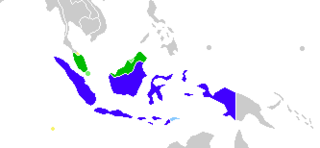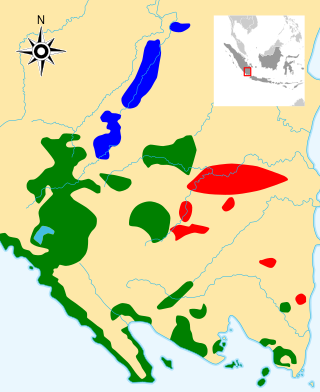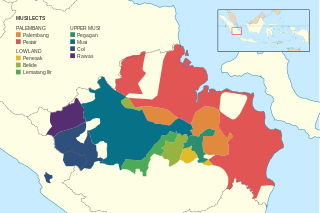Related Research Articles

Malay is an Austronesian language that is an official language of Brunei, Indonesia, Malaysia, and Singapore, and that is also spoken in East Timor and parts of Thailand. Altogether, it is spoken by 290 million people across Maritime Southeast Asia.

Minangkabau is an Austronesian language spoken by the Minangkabau of West Sumatra, the western part of Riau, South Aceh Regency, the northern part of Bengkulu and Jambi, also in several cities throughout Indonesia by migrated Minangkabau. The language is also a lingua franca along the western coastal region of the province of North Sumatra, and is even used in parts of Aceh, where the language is called Aneuk Jamee.
In addition to its classical and modern literary form, Malay had various regional dialects established after the rise of the Srivijaya empire in Sumatra, Indonesia. Also, Malay spread through interethnic contact and trade across the south East Asia Archipelago as far as the Philippines. That contact resulted in a lingua franca that was called Bazaar Malay or low Malay and in Malay Melayu Pasar. It is generally believed that Bazaar Malay was a pidgin, influenced by contact among Malay, Hokkien, Portuguese, and Dutch traders.
Manado Malay, or simply the Manado language, is a creole language spoken in Manado, the capital of North Sulawesi province in Indonesia, and the surrounding area. The local name of the language is bahasa Manado, and the name Minahasa Malay is also used, after the main ethnic group speaking the language. Since Manado Malay is used primarily for spoken communication, there is no standard orthography.

Malaysian Malay or Malaysian —endonymically within Malaysia as Standard Malay or simply Malay — is a standardized form of the Malay language used in Malaysia and also used in Brunei and Singapore. Malaysian Malay is standardized from the Johore-Riau dialect of Malay, particularly a branch spoken in the state of Johore south of the Malay Peninsula. It is spoken by much of the Malaysian population, although most learn a vernacular form of Malay or another native language first. Malay is a compulsory subject in primary and secondary schools.

The Kedayan are an ethnic group residing in Brunei, Federal Territory of Labuan, southwest of Sabah, and north of Sarawak on the island of Borneo. According to the Language and Literature Bureau of Brunei, the Kedayan language is spoken by about 30,000 people in Brunei, and it has been claimed that there are a further 46,500 speakers in Sabah and 37,000 in Sarawak. In Sabah, the Kedayan mainly live in the southern districts of Sipitang and Beaufort, where they are counted as a part of the local Malay populace. Whilst in Sarawak, the Kedayans mostly reside in the towns of Lawas, Limbang and Miri.

Malay was first used in the first millennia known as Old Malay, a part of the Austronesian language family. Over a period of two millennia, Malay has undergone various stages of development that derived from different layers of foreign influences through international trade, religious expansion, colonisation and developments of new socio-political trends. The oldest form of Malay is descended from the Proto-Malayo-Polynesian language spoken by the earliest Austronesian settlers in Southeast Asia. This form would later evolve into Old Malay when Indian cultures and religions began penetrating the region, most probably using the Kawi and Rencong scripts, some linguistic researchers say. Old Malay contained some terms that exist today, but are unintelligible to modern speakers, while the modern language is already largely recognisable in written Classical Malay of 1303 CE.

The Malayic languages are a branch of the Malayo-Polynesian subgroup of the Austronesian language family. The most prominent member is Malay, a pluricentric language given national status in Brunei and Singapore while also the basis for national standards Malaysian in Malaysia and Indonesian in Indonesia. The Malayic branch also includes local languages spoken by ethnic Malays, further several languages spoken by various other ethnic groups of Sumatra, Indonesia and Borneo even as far as Urak Lawoi in the southwestern coast of Thailand.
Tidore is a language of North Maluku, Indonesia, spoken by the Tidore people. The language is centered on the island of Tidore, but it is also spoken in some areas of the neighbouring Halmahera. Historically, it was the primary language of the Sultanate of Tidore, a major Moluccan Muslim state.

Lampung or Lampungic is an Austronesian language or dialect cluster with around 1.5 million native speakers, who primarily belong to the Lampung ethnic group of southern Sumatra, Indonesia. It is divided into two or three varieties: Lampung Api, Lampung Nyo, and Komering. The latter is sometimes included in Lampung Api, sometimes treated as an entirely separate language. Komering people see themselves as ethnically separate from, but related to, Lampung people.
Sangir, also known as Sangihé, Sangi, Sangil, or Sangih, is an Austronesian language spoken on the islands linking northern Sulawesi, Indonesia, with Mindanao, Philippines by the Sangir people. It belongs to the Philippine group within the Austronesian language family.
The Gorontalo language is a language spoken in Gorontalo Province, Sulawesi, Indonesia by the Gorontalo people. With around one million speakers, it is a major language of northern Sulawesi.
Sarawak Malay is a Malayic language native to the State of Sarawak. It is a common language used by natives of Sarawak and also as the important mother tongue for the Sarawakian Malay people.
The Minahasan languages are a subgroup of the Austronesian languages spoken by the Minahasa people in northern Sulawesi, Indonesia. They belong to the Philippine subgroup.

Palembang, also known as Palembang Malay, is a Malayic variety of the Musi dialect chain primarily spoken in the city of Palembang and nearby lowlands, and also as a lingua franca throughout South Sumatra. Since parts of the region used to be under direct Javanese rule for quite a long time, Palembang is significantly influenced by Javanese, down to its core vocabularies.

Larantuka Malay, also known as Nagi, is a Malay-based creole language spoken in the eastern part of Flores in Indonesia, especially in Larantuka. It is a derivative of Malay which is thought to originate from Malacca. It is a language with unspecified linguistic affiliation. According to 2007 data, this language is spoken by 20,000 speakers, mainly the people of East Flores. Larantuka Malay is the mother tongue of the Nagi people. Then it also functions as a second language for several nearby communities.
Ternate is a language of northern Maluku, eastern Indonesia. It is spoken by the Ternate people, who inhabit the island of Ternate, as well as many other areas of the archipelago. It is the dominant indigenous language of North Maluku, historically important as a regional lingua franca. A North Halmahera language, it is unlike most languages of Indonesia which belong to the Austronesian language family.
Pahang Malay is a Malayic language spoken in the Malaysian state of Pahang. It is regarded as the dominant Malay dialect spoken along the vast riverine systems of Pahang, but co-exists with other Malay dialects traditionally spoken in the state. Along the coastline of Pahang, Terengganu Malay is spoken in a narrow strip of sometimes discontiguous fishing villages and towns. Another dialect spoken in Tioman island is a distinct Malay variant and most closely related to Riau Archipelago Malay subdialect spoken in Natuna and Anambas islands in the South China Sea, together forming a dialect continuum between the Bornean Malay and the Mainland Peninsular/Sumatran Malay.
Perak Malay is one of the Malay dialects spoken within the state of Perak, Malaysia. Although it is neither the official language nor the standard dialect in the whole state of Perak, its existence which co-exists with other major dialects in the state of Perak still plays an important role in maintaining the identity of Perak. In spite of the fact that there are five main dialects traditionally spoken in Perak, only one of which is intended by the name "Perak Malay". There are subtle phonetic, syntactic and lexical distinctions from other major Malay dialects. Perak Malay can be divided into two sub-dialects, Kuala Kangsar and Perak Tengah, named after the daerah (districts) where they are predominantly spoken.

James T. Collins is an American linguist who works on comparative linguistics, lexicography, and sociolinguistics. Collins specializes primarily in Austronesian languages.
References
- 1 2 3 Adelaar et al. (1996), p. 682.
- 1 2 Collins (1996a).
- ↑ Collins (1994b), p. 655.
- 1 2 3 4 Collins (2018), p. 16.
- ↑ Collins (2018), p. 11–12.
- 1 2 3 4 5 Collins (1996a), p. 151.
- 1 2 3 Collins (1996b), p. 78.
- ↑ Collins (2022), "The Bacan community is a diaspora community of Malay speakers who migrated the furthest from the western archipelago.".
- ↑ Udinsah (1958).
- 1 2 3 Collins (1996a), p. 146.
- 1 2 3 Collins (2022).
- ↑ Hidayah (2015), p. 43.
- 1 2 Collins (1995), p. 229.
- 1 2 Collins (1996b), p. 74.
- 1 2 Udinsah (1958), p. 29.
- ↑ Lewis (2009).
- ↑ Eberhard, Simons & Fennig (2019).
- ↑ Collins (2018), p. 18.
- ↑ Collins (1982), p. 81.
- ↑ Collins (2018), p. 19.
- ↑ Collins (1994a).
- ↑ van Minde (1997), p. 14.
- ↑ Steinhauer (1991), p. 178.
- ↑ Kluge (2017), p. 2–10.
- ↑ Collins (1996a), p. 146, 148.
- ↑ Adelaar (1992), p. 5.
- ↑ Collins (1996b), p. 83–84.
- ↑ Collins (1994a), p. 631.
- ↑ Collins (1982), p. 80.
- 1 2 Collins (1996b), p. 77.
- ↑ Grimes & Grimes (1994), p. 45.
- ↑ Collins (2018), p. 14–15.
- ↑ Wallace (1869), p. 43.
- ↑ Collins (1996b).